Green Lantern theme by Big Nes
Download: GreenLantern.p3t
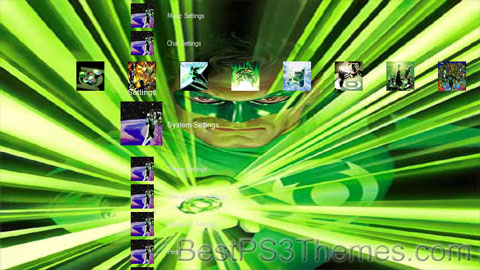
(11 backgrounds)
| Green Lantern | |
|---|---|
 Cover of Green Lantern: Rebirth #6 (May 2005) Pictured left to right: Guy Gardner, Kyle Rayner, Hal Jordan, John Stewart, and Kilowog. Art by Ethan Van Sciver. | |
| Publisher | DC Comics |
| First appearance | All-American Comics #16 (July 1940) |
| Created by | Alan Scott: Martin Nodell Bill Finger Hal Jordan: John Broome Gil Kane John Stewart: Dennis O'Neil Neal Adams |
| Characters | Alan Scott Hal Jordan Guy Gardner John Stewart Kyle Rayner Simon Baz Jessica Cruz Sojourner Mullein |
| See also | Green Lantern Corps |
Green Lantern is the name of several superheroes appearing in American comic books published by DC Comics. They fight evil with the aid of rings that grant them a variety of extraordinary powers, all of which come from imagination, fearlessness, and the electromagnetic spectrum of emotional willpower.[1] The characters are typically depicted as members of the Green Lantern Corps, an intergalactic law enforcement agency.
The first Green Lantern character, Alan Scott, was created in 1940 by Martin Nodell with scripting or co-scripting of the first stories by Bill Finger[2] during the Golden Age of Comic Books and usually fought common criminals in Capitol City (and later, Gotham City) with the aid of his magic ring. For the Silver Age of Comic Books, John Broome and Gil Kane reinvented the character as Hal Jordan in 1959 and introduced the Green Lantern Corps, shifting the nature of the character from fantasy to science fiction. During the Bronze Age of Comic Books, Dennis O'Neil and Neal Adams introduced John Stewart, a new member of the Corps who was one of DC's first black superheroes. Other notable Green Lanterns include Guy Gardner, Kyle Rayner, Simon Baz, Jessica Cruz and Jo Mullein.
The Green Lanterns are among DC Comics' longest lasting sets of characters. They have been adapted to television, video games, and motion pictures.
Publication history[edit]
Timeline[edit]

Golden Age[edit]
Martin Nodell (initially using the pen-name Mart Dellon) created the first Green Lantern in collaboration with Bill Finger. He first appeared in the Golden Age of Comic Books in All-American Comics #16 (July 1940), published by All-American Publications, one of three companies that would eventually merge to form DC Comics.[3]
This Green Lantern's real name was Alan Scott, a railroad engineer who, after a railway crash, came into possession of a magic lantern which spoke to him and said it would bring power. From this, he crafted a magic ring that gave him a wide variety of powers. The limitations of the ring were that it had to be "charged" every 24 hours by touching it to the lantern for a time and that it could not directly affect objects made of wood. Alan Scott fought mostly ordinary human villains, but he did have a few paranormal ones such as the immortal Vandal Savage and the zombie Solomon Grundy. Most stories took place in New York. Green Lantern rings are made from magic.
As a popular character in the 1940s, the Green Lantern featured both in anthology books such as All-American Comics and Comic Cavalcade, as well as his own book, Green Lantern. He also appeared in All Star Comics as a member of the superhero team known as the Justice Society of America.
After World War II the popularity of superheroes in general declined. The Green Lantern comic book was cancelled with issue #38 (May–June 1949), and All Star Comics #57 (1951) was the character's last Golden Age appearance. When superheroes came back in fashion in later decades, the character Alan Scott was revived, but he was forever marginalized by the new Hal Jordan character who had been created to supplant him (see below). Initially, he made guest appearances in other superheroes' books, but eventually got regular roles in books featuring the Justice Society. He never got another solo series, although he did star in individual stories and in the single-issue 2002 comic book Brightest Day, Blackest Night.[4] Between 1995 and 2003, DC Comics changed Alan Scott's superhero codename to "Sentinel" in order to distinguish him from the newer and more popular science fictional Green Lanterns.
In 2011, the Alan Scott character was revamped. His costume was redesigned to be all green and the source of his powers was changed to that of the mystical power of nature (referred to in the stories as "the Green").
Silver Age[edit]
In 1959, Julius Schwartz reinvented the Green Lantern character as a science fiction hero named Hal Jordan. Hal Jordan's powers were more or less the same as Alan Scott's, but otherwise this character was completely different from the Green Lantern character of the 1940s. He had a new name, a redesigned costume, and a rewritten origin story. Hal Jordan received his ring from a dying alien and was commissioned as an officer of the Green Lantern Corps, an interstellar law enforcement agency overseen by the Guardians of the Universe.[5]
Hal Jordan was introduced in Showcase #22 (September–October 1959). Gil Kane and Sid Greene were the art team most notable on the title in its early years, along with writer John Broome. His initial physical appearance, according to Kane, was patterned after his one-time neighbor, actor Paul Newman.[6]
Later developments[edit]
With issue #76 (April 1970), the series made a radical stylistic departure. Editor Schwartz, in one of the company's earliest efforts to provide more than fantasy, worked with the writer-artist team of Denny O'Neil and Neal Adams to spark new interest in the comic book series and address a perceived need for social relevance. They added the character Green Arrow (with the cover, but not the official name, retitled Green Lantern Co-Starring Green Arrow) and had the pair travel through America encountering "real world" issues, to which they reacted in different ways — Green Lantern as fundamentally a lawman, Green Arrow as a liberal iconoclast. Additionally during this run, the groundbreaking "Snowbirds Don't Fly" story was published (issues #85–86) in which Green Arrow's teen sidekick Speedy (the later grown-up hero Red Arrow) developed a heroin addiction that he was forcibly made to quit. The stories were critically acclaimed, with publications such as The New York Times, The Wall Street Journal, and Newsweek citing it as an example of how comic books were "growing up".[7] However, the O'Neil/Adams run was not a commercial success, and the series was cancelled after only 14 issues, though an additional unpublished three installments were finally published as back-ups in The Flash #217–219.[8]
The title saw a number of revivals and cancellations. It changed to Green Lantern Corps at one point as the popularity rose and waned. During a time there were two regular titles, each with a Green Lantern, and a third member in the Justice League. A new character, Kyle Rayner, was created to become the feature while Hal Jordan first became the villain Parallax, then died and came back as the Spectre.
In the wake of The New Frontier, writer Geoff Johns returned Hal Jordan as Green Lantern in Green Lantern: Rebirth (2004–05). Johns began to lay the groundwork for "Blackest Night" (released July 13, 2010)[9]), viewing it as the third part of the trilogy started by Rebirth. Expanding on the Green Lantern mythology in the second part, "Sinestro Corps War" (2007), Johns, with artist Ethan van Sciver, found wide critical acclaim and commercial success with the series, which promised the introduction of a spectrum of colored "lanterns".
Awards[edit]
The series and its creators have received several awards over the years, including the 1961 Alley Award for Best Adventure Hero/Heroine with Own Book[10] and the Academy of Comic Book Arts Shazam Award for Best Continuing Feature in 1970, for Best Individual Story ("No Evil Shall Escape My Sight", Green Lantern (vol. 2) #76 by Dennis O'Neil and Neal Adams),[11] and in 1971 for Best Individual Story ("Snowbirds Don't Fly", Green Lantern (vol. 2) #85 by O'Neil and Adams).[12]
Writer O'Neil received the Shazam Award for Best Writer (Dramatic Division) in 1970 for his work on Green Lantern, Batman, Superman and other titles, while artist Adams received the Shazam for Best Artist (Dramatic Division) in 1970 for his work on Green Lantern and Batman.[11] Inker Dick Giordano received the Shazam Award for Best Inker (Dramatic Division) for his work on Green Lantern and other titles.[11]
In Judd Winick's first regular writing assignment on Green Lantern, he wrote a storyline in which an assistant of Kyle Rayner's emerged as a gay character in Green Lantern (vol. 3) #137 (June 2001). In Green Lantern (vol. 3) #154 (November 2001) the story entitled "Hate Crime" gained media recognition when his friend Terry Berg was brutally beaten in a homophobic attack. Winick was interviewed on Phil Donahue's show on MSNBC for that storyline on August 15, 2002[13] and received two GLAAD Media Awards for his Green Lantern work.[14]
In May 2011, Green Lantern placed 7th on IGN's Top 100 Comic Book Heroes of All Time.[15]
Legal disputes[edit]
DC Comics has been involved in two disputes concerning Green Lantern trade marks before the United States Patent and Trade Mark Office, the first in 2012 and the second in 2016.[16]
Characters[edit]
Golden Age Green Lantern[edit]
Silver Age Green Lantern[edit]
Bronze Age Green Lanterns[edit]
Modern Age Green Lanterns[edit]
- Kyle Rayner[19]
- Simon Baz
- Jessica Cruz
- Sojourner Mullein
- Keli Quintela
[edit]
Powers and abilities[edit]
Each Green Lantern wears a ring that grants them a variety of abilities. The ring is powered by willpower. The full extent of the ring's abilities has never been rigorously defined in the stories, but two consistent traits are that it grants the power of flight and that all of its effects are accompanied by a green light.
Green Lantern Oath[edit]
In issue #9 of the original Alan Scott Green Lantern comic book, scriptwriter Alfred Bester, best known as a major science fiction novelist of the 1950s (and one who had included rhymed couplets in his work) introduced the trademark Green Lantern Oaths:[27]
In brightest day, in darkest night
No evil shall escape my sight!
Let those who worship evil's might
Beware my power ― Green Lantern's light!
This oath was revived for the Hal Jordan version of the character. Alan Moore and Geoff Johns introduced variants.[28] Oftentimes "darkest night" is changed to "blackest night", which inspired the name of the crossover event Blackest Night. In reference to the oath, the sequel to Blackest Night was called Brightest Day.
In other media[edit]
Film[edit]
Standalone film[edit]
Hal Jordan made his live-action debut in the 2011 film of the same name, portrayed by Ryan Reynolds.[29] The film originally intended on launching a new DC Comics cinematic franchise with a sequel and an untitled Flash film, but due to the film's failure, nothing moved forward.
DC Extended Universe[edit]
John Stewart was scheduled to appear in Zack Snyder's director cut of Justice League, portrayed by Wayne T. Carr, but the scene was reworked with Martian Manhunter, portrayed by Harry Lennix, at the request of Warner Bros.[30]
Television[edit]
In the live-action television series Stargirl, Alan Scott's power battery is shown in a flashback to when the Injustice Society attacked the Justice Society of America's headquarters. JSA member Pat Dugan hid his power battery in his basement. In the second season, Alan Scott's daughter Jennie-Lynn Scott finds Alan's power battery and activates it. She absorbs the battery's energy and breaks it. She then leaves Blue Valley to find her missing brother Todd Rice.
DC Universe[edit]
A live-action Green Lantern television series was announced to be in development at HBO Max set to feature the Alan Scott, Guy Gardner, Jessica Cruz, and Simon Baz versions of Green Lantern along with an original character Bree Jarta with Finn Wittrock and Jeremy Irvine portraying Gardner and Scott respectively.[31] The series will be set in multiple time periods focusing on a separate story for each of the Green Lanterns for that time.[32] In October 2022, it was announced that the series had instead been extensively redeveloped into a solo project centered around John Stewart.[33] In December 2022, sources claimed the series was scrapped, but James Gunn say the series is still in production.[34][35] The series' title was revealed to be Lanterns in January 2023. The version with Berlanti was confirmed to have been cancelled, with this new series focusing on Stewart and Hal Jordan as part of DC Studios' new DC Universe.[36]
In academic and journalistic jargon[edit]
Some political pundits and academic political scientists use the phrase "Green Lanternism" (or "political Green Lanternism") to refer to the common tendency to demand perfection or omnipotence from political leaders, and to blame actually unsolvable or inevitable problems on political leaders' alleged weakness or malice, as if political office-holders' powers and abilities, like Green Lantern's powers and abilities, were limited only by their personal strength of will.[37][38]
See also[edit]
- Doctor Spectrum, a Marvel Comics homage to Green Lantern
- Green Lantern: The Animated Series
- Green Lantern Corps
References[edit]
- ^ Wallace, Dan (2008), "Green Lantern's Power Ring", in Dougall, Alastair (ed.), The DC Comics Encyclopedia, New York: Dorling Kindersley, p. 93, ISBN 978-0-7566-4119-1, OCLC 213309017
- ^ "TwoMorrows Publishing – Alter Ego #5 – Mart Nodell Interview". twomorrows.com. Retrieved 2021-11-27.
- ^ Benton, Mike (1992). Superhero Comics of the Golden Age: The Illustrated History. Dallas: Taylor Publishing Company. pp. 104-105. ISBN 0-87833-808-X. Retrieved 15 January 2020.
- ^ Seagle, Steven T; Snyder, John K III (2002). Green Lantern: Brightest Day, Blackest Night. DC Comics.
- ^ Albert, Aaron. "Green Lantern – Hal Jordan Profile". Archived from the original on 17 January 2013. Retrieved 17 January 2013.
- ^ Stowe, Dusty (3 August 2017). "15 Things You Didn't Know About Green Lantern". Screenrant.com. Screen Rant, Inc. Retrieved 9 November 2019.
- ^ Wright, Bradford W. Comic Book Nation. Johns Hopkins, 2001. p. 227
- ^ Wells, John (December 2010). "Green Lantern/Green Arrow: And Through Them Change an Industry". Back Issue! (#45). TwoMorrows Publishing: 39–54.
- ^
Downtown Pro V1
Downtown Pro V1 theme by ltmreal
Download: DowntownProV1.p3t
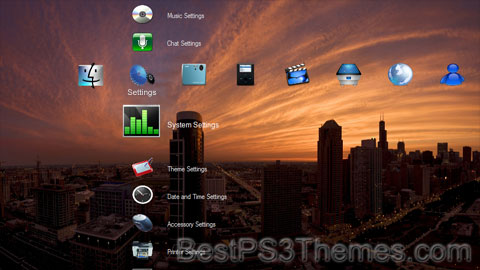
(1 background)
P3T Unpacker v0.12
Copyright (c) 2007. Anoop MenonThis program unpacks Playstation 3 Theme files (.p3t) so that you can touch-up an existing theme to your likings or use a certain wallpaper from it (as many themes have multiple). But remember, if you use content from another theme and release it, be sure to give credit!
Download for Windows: p3textractor.zip
Instructions:
Download p3textractor.zip from above. Extract the files to a folder with a program such as WinZip or WinRAR. Now there are multiple ways to extract the theme.
The first way is to simply open the p3t file with p3textractor.exe. If you don’t know how to do this, right click the p3t file and select Open With. Alternatively, open the p3t file and it will ask you to select a program to open with. Click Browse and find p3textractor.exe from where you previously extracted it to. It will open CMD and extract the theme to extracted.[filename]. After that, all you need to do for any future p3t files is open them and it will extract.
The second way is very simple. Just drag the p3t file to p3textractor.exe. It will open CMD and extract the theme to extracted.[filename].
For the third way, first put the p3t file you want to extract into the same folder as p3textractor.exe. Open CMD and browse to the folder with p3extractor.exe. Enter the following:
p3textractor filename.p3t [destination path]Replace filename with the name of the p3t file, and replace [destination path] with the name of the folder you want the files to be extracted to. A destination path is not required. By default it will extract to extracted.filename.Gold Melter
Gold Melter theme by Jabyaeye
Download: GoldMelter.p3t
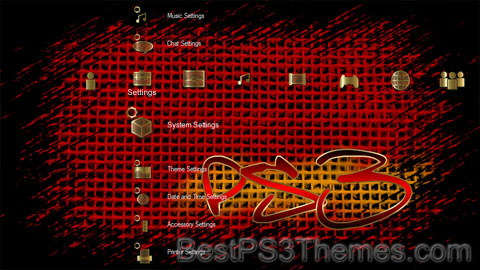
(2 backgrounds)
P3T Unpacker v0.12
Copyright (c) 2007. Anoop MenonThis program unpacks Playstation 3 Theme files (.p3t) so that you can touch-up an existing theme to your likings or use a certain wallpaper from it (as many themes have multiple). But remember, if you use content from another theme and release it, be sure to give credit!
Download for Windows: p3textractor.zip
Instructions:
Download p3textractor.zip from above. Extract the files to a folder with a program such as WinZip or WinRAR. Now there are multiple ways to extract the theme.
The first way is to simply open the p3t file with p3textractor.exe. If you don’t know how to do this, right click the p3t file and select Open With. Alternatively, open the p3t file and it will ask you to select a program to open with. Click Browse and find p3textractor.exe from where you previously extracted it to. It will open CMD and extract the theme to extracted.[filename]. After that, all you need to do for any future p3t files is open them and it will extract.
The second way is very simple. Just drag the p3t file to p3textractor.exe. It will open CMD and extract the theme to extracted.[filename].
For the third way, first put the p3t file you want to extract into the same folder as p3textractor.exe. Open CMD and browse to the folder with p3extractor.exe. Enter the following:
p3textractor filename.p3t [destination path]Replace filename with the name of the p3t file, and replace [destination path] with the name of the folder you want the files to be extracted to. A destination path is not required. By default it will extract to extracted.filename.Boat On The Water
Boat On The Water theme by ltmreal
Download: BoatOnTheWater.p3t

(4 backgrounds)
P3T Unpacker v0.12
Copyright (c) 2007. Anoop MenonThis program unpacks Playstation 3 Theme files (.p3t) so that you can touch-up an existing theme to your likings or use a certain wallpaper from it (as many themes have multiple). But remember, if you use content from another theme and release it, be sure to give credit!
Download for Windows: p3textractor.zip
Instructions:
Download p3textractor.zip from above. Extract the files to a folder with a program such as WinZip or WinRAR. Now there are multiple ways to extract the theme.
The first way is to simply open the p3t file with p3textractor.exe. If you don’t know how to do this, right click the p3t file and select Open With. Alternatively, open the p3t file and it will ask you to select a program to open with. Click Browse and find p3textractor.exe from where you previously extracted it to. It will open CMD and extract the theme to extracted.[filename]. After that, all you need to do for any future p3t files is open them and it will extract.
The second way is very simple. Just drag the p3t file to p3textractor.exe. It will open CMD and extract the theme to extracted.[filename].
For the third way, first put the p3t file you want to extract into the same folder as p3textractor.exe. Open CMD and browse to the folder with p3extractor.exe. Enter the following:
p3textractor filename.p3t [destination path]Replace filename with the name of the p3t file, and replace [destination path] with the name of the folder you want the files to be extracted to. A destination path is not required. By default it will extract to extracted.filename.Early Morning In The City
Early Morning In The City theme by ltmreal
Download: EarlyMorningInTheCity.p3t

(4 backgrounds)
P3T Unpacker v0.12
Copyright (c) 2007. Anoop MenonThis program unpacks Playstation 3 Theme files (.p3t) so that you can touch-up an existing theme to your likings or use a certain wallpaper from it (as many themes have multiple). But remember, if you use content from another theme and release it, be sure to give credit!
Download for Windows: p3textractor.zip
Instructions:
Download p3textractor.zip from above. Extract the files to a folder with a program such as WinZip or WinRAR. Now there are multiple ways to extract the theme.
The first way is to simply open the p3t file with p3textractor.exe. If you don’t know how to do this, right click the p3t file and select Open With. Alternatively, open the p3t file and it will ask you to select a program to open with. Click Browse and find p3textractor.exe from where you previously extracted it to. It will open CMD and extract the theme to extracted.[filename]. After that, all you need to do for any future p3t files is open them and it will extract.
The second way is very simple. Just drag the p3t file to p3textractor.exe. It will open CMD and extract the theme to extracted.[filename].
For the third way, first put the p3t file you want to extract into the same folder as p3textractor.exe. Open CMD and browse to the folder with p3extractor.exe. Enter the following:
p3textractor filename.p3t [destination path]Replace filename with the name of the p3t file, and replace [destination path] with the name of the folder you want the files to be extracted to. A destination path is not required. By default it will extract to extracted.filename.Nascar #2
Nascar theme by SebChevy18
Download: Nascar_2.p3t
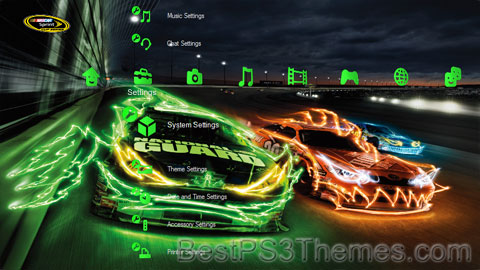
(4 backgrounds)
Redirect to:
This page is a redirect. The following categories are used to track and monitor this redirect:When appropriate, protection levels are automatically sensed, described and categorized.- From other capitalisation: This is a redirect from a title with another method of capitalisation. It leads to the title in accordance with the Wikipedia naming conventions for capitalisation, or it leads to a title that is associated in some way with the conventional capitalisation of this redirect title. This may help writing, searching and international language issues.
- If this redirect is an incorrect capitalisation, then {{R from miscapitalisation}} should be used instead, and pages that use this link should be updated to link directly to the target. Miscapitalisations can be tagged in any namespace.
- Use this rcat to tag only mainspace redirects; when other capitalisations are in other namespaces, use {{R from modification}} instead.
Circuits Nascar
Circuits Nascar theme by SebChevy18
Download: CircuitsNascar.p3t
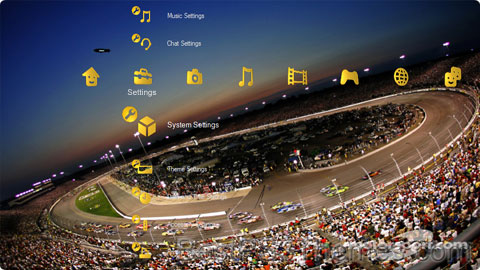
(6 backgrounds)
P3T Unpacker v0.12
Copyright (c) 2007. Anoop MenonThis program unpacks Playstation 3 Theme files (.p3t) so that you can touch-up an existing theme to your likings or use a certain wallpaper from it (as many themes have multiple). But remember, if you use content from another theme and release it, be sure to give credit!
Download for Windows: p3textractor.zip
Instructions:
Download p3textractor.zip from above. Extract the files to a folder with a program such as WinZip or WinRAR. Now there are multiple ways to extract the theme.
The first way is to simply open the p3t file with p3textractor.exe. If you don’t know how to do this, right click the p3t file and select Open With. Alternatively, open the p3t file and it will ask you to select a program to open with. Click Browse and find p3textractor.exe from where you previously extracted it to. It will open CMD and extract the theme to extracted.[filename]. After that, all you need to do for any future p3t files is open them and it will extract.
The second way is very simple. Just drag the p3t file to p3textractor.exe. It will open CMD and extract the theme to extracted.[filename].
For the third way, first put the p3t file you want to extract into the same folder as p3textractor.exe. Open CMD and browse to the folder with p3extractor.exe. Enter the following:
p3textractor filename.p3t [destination path]Replace filename with the name of the p3t file, and replace [destination path] with the name of the folder you want the files to be extracted to. A destination path is not required. By default it will extract to extracted.filename.Cars #2
Cars theme by CpDude
Download: Cars_2.p3t
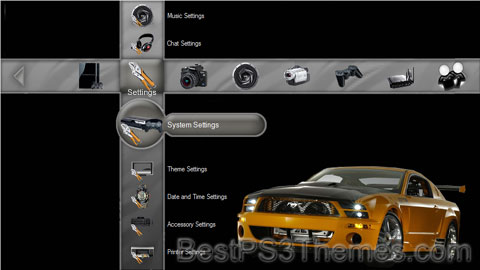
(2 backgrounds)
Redirect to:
This page is a redirect. The following categories are used to track and monitor this redirect:- From a printworthy page title: This is a redirect from a title that would be helpful in a printed or CD/DVD version of Wikipedia. See Wikipedia:Printability and Version 1.0 Editorial Team for more information.
- From the plural form: This is a redirect from a plural noun to its singular form.
- This redirect link is used for convenience; it is often preferable to add the plural directly after the link (for example,
[[link]]s). However, do not replace these redirected links with a simpler link unless the page is updated for another reason (see WP:NOTBROKEN). - Use this rcat to tag only mainspace redirects; when plural forms are found in other namespaces, use {{R from modification}} instead.
- This redirect link is used for convenience; it is often preferable to add the plural directly after the link (for example,
When appropriate, protection levels are automatically sensed, described and categorized.- Mentioned in a hatnote: This is a redirect from a title that is mentioned in a hatnote at the redirect target. The mention is usually atop the target article. It may, however, be directly under a section header, or in another article's hatnote (whenever the hatnote is under a section, {{R to section}} should also be used).
- The titles of redirects mentioned in hatnotes may refer to a subject other than that of the target page. It is possible that this redirect may need to be retargeted, or become an article under its own title (see {{R with possibilities}}). If the title is a good candidate for a Wiktionary link, it may also be added.
St. Louis Cardinals
St. Louis Cardinals theme by Ryan Specht
Download: StLouisCardinals.p3t
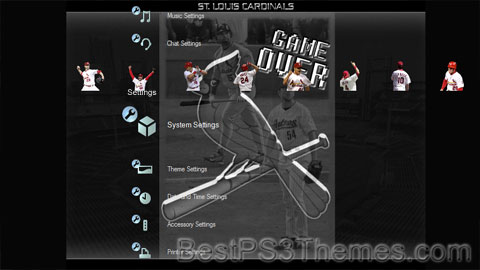
(1 background)
St. Louis Cardinals  2024 St. Louis Cardinals season
2024 St. Louis Cardinals season- Established in 1882
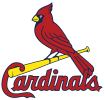

Team logo Cap insignia Major league affiliations - National League (1892–present)
- Central Division (1994–present)
- East Division (1969–1993)
- American Association (1882–1891)
Current uniform 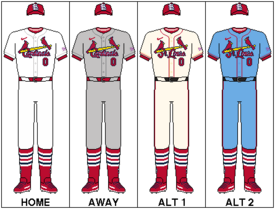
Retired numbers Colors Name Other nicknames - The Cards
- The Redbirds
- The Birds
- The Baseball Cardinals (1960–1987)
Ballpark - Busch Stadium (2006–present)
- Busch Memorial Stadium (1966–2005)[a]
- Robison Field (1893–1920)[b]
- Sportsman's Park (1882–1892, 1920–1966)[c]
Major league titles World Series titles (11) NL Pennants (19) AA Pennants (4) Central Division titles (12) East Division titles (3)[d] Pre-modern World Series (1) Wild card berths (5)[e] Front office Principal owner(s) Bill DeWitt Jr.[4] President Bill DeWitt III President of baseball operations John Mozeliak General manager Mike Girsch Manager Oliver Marmol Mascot(s) Fredbird, Rally Squirrel Website mlb.com/cardinals The St. Louis Cardinals are an American professional baseball team based in St. Louis. The Cardinals compete in Major League Baseball (MLB) as a member club of the National League (NL) Central Division. Since the 2006 season, the Cardinals have played their home games at Busch Stadium in downtown St. Louis. One of the nation's oldest and most successful professional baseball clubs, the Cardinals have won 11 World Series championships, the most of any NL team and second in MLB only to the New York Yankees.[5][6] The team has won 19 National League pennants, third-most of any team behind the Los Angeles Dodgers and San Francisco Giants. St. Louis has also won 15 division titles in the East and Central divisions.
In 1881, entrepreneur Chris von der Ahe purchased the Brown Stockings barnstorming club, renamed it the St. Louis Browns, and made it a charter member of the American Association baseball league. The team won four league championships, qualifying them to play in the era's professional baseball championship series, a forerunner of the modern World Series.[7] In two of these championships, the Browns met the Chicago White Stockings, now the Chicago Cubs, launching the enduring Cardinals–Cubs rivalry.
In 1892, the Browns – also called the Perfectos – joined the National League. In 1900, the team was renamed the Cardinals. (Two years later, an unrelated St. Louis Browns team joined the American League.)
Notable Cardinals achievements include manager/owner Branch Rickey's invention of the farm system, Rogers Hornsby's two batting Triple Crowns, Dizzy Dean's 30-win season in 1934, Stan Musial's 17 MLB and 29 NL records, Bob Gibson's 1.12 earned run average (ERA) in 1968, Whitey Herzog's Whiteyball, Mark McGwire's single-season home run record in 1998, the 2011 championship team's unprecedented comebacks,[8] and Albert Pujols’ 700th home run. The Cardinals have won 105 or more games in four seasons and won 100 or more nine times. Cardinals players have won 21 league MVPs, four batting Triple Crowns, and three Cy Young Awards. Baseball Hall of Fame inductees include Lou Brock, Dizzy Dean, Bob Gibson, Whitey Herzog, Rogers Hornsby, Tony LaRussa, Joe Medwick, Stan Musial, Enos Slaughter, Branch Rickey, Red Schoendienst, Ozzie Smith, Ted Simmons, Bruce Sutter, and Scott Rolen.
In 2018, Forbes valued the Cardinals at $1.9 billion, the 7th-highest among MLB clubs and far more than the $147 million paid in 1995 by owner William DeWitt Jr.'s investment group. In 2017, the team took in revenue of $319 million on an operating income of $40.0 million.[9][10][11] John Mozeliak is the President of Baseball Operations, Mike Girsch is the general manager, and Oliver Marmol is the manager.[12][13] The Cardinals are renowned for their strong fan support: despite being in one of the sport's mid-level markets, they routinely see attendances among the league's highest, and are consistently among the top three in MLB in local television ratings.[14][15]
Through 2023, the Cardinals' all-time win-loss record is 11,202–10,323–152 (.520).[16]
History[edit]
Before the Cardinals (1875–1881)[edit]
Professional baseball began in St. Louis with the inception of the Brown Stockings in the National Association (NA) in 1875. The NA folded following that season, and the next season, St. Louis joined the National League as a charter member, finishing in third place at 45–19. George Bradley hurled the first no-hitter in Major League history. The NL expelled St. Louis from the league after 1877 due to a game-fixing scandal and the team went bankrupt.[17] Without a league, they continued play as a semi-professional barnstorming team through 1881.
The magnitudes of the reorganizations, following the 1877 and 1881 seasons, are such that the 1875–1877 and 1878–1881 Brown Stockings teams are not generally considered to share continuity as a franchise with the current St. Louis Cardinals.[18][19]
American Association and early National League eras (1882–1919)[edit]
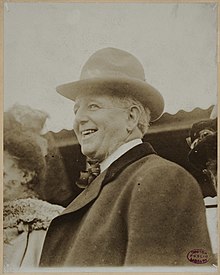
Charles Comiskey, shown here circa 1910, guided the Browns to four American Association titles. For the 1882 season, Chris von der Ahe purchased the team, reorganized it, and made it a founding member of the American Association (AA), a league to rival the NL.[20] 1882 is generally considered to be the first year of existence for the franchise which would later become known as the St. Louis Cardinals.[18][19][21][f]
The next season, St. Louis shortened their name to the Browns. Soon thereafter they became the dominant team in the AA, as manager Charlie Comiskey guided St. Louis to four pennants in a row from 1885 to 1888.[7][24] Pitcher and outfielder Bob Caruthers led the league in ERA (2.07) and wins (40) in 1885 and finished in the top six in both in each of the following two seasons. He also led the AA in OBP (.448) and OPS (.974) in 1886 and finished fourth in batting average in 1886 (.334) and fifth in 1887 (.357).[25] Outfielder Tip O'Neill won the first batting triple crown in franchise history in 1887 and the only one in AA history.[26][27][28] By winning the pennant, the Browns played the NL pennant winner in a predecessor of the World Series. The Browns twice met the Chicago White Stockings—the predecessor to the Chicago Cubs—tying one in a heated dispute and winning the other, thus spurring the vigorous St. Louis-Chicago rivalry that ensues to this day.[29] During the franchise's ten seasons in the AA, they compiled an all-time league-high of 780 wins and .639 winning percentage. They lost just 432 contests while tying 21 others.[7]

Rogers Hornsby won two Triple Crowns as a Cardinal.[28] The AA went bankrupt after the 1891 season and the Browns transferred to the National League. This time, the club entered an era of stark futility. Between 1892 and 1919, St. Louis managed just five winning seasons, finished in last or next-to-last place sixteen times, and ended four seasons with 100 losses or more. The nadir was the 1897 season: a 29–102 record for a franchise-worst .221 winning percentage.[7] St. Louis' 84–67 finish as the Perfectos in 1899 would be the team's best finish between the AA era and Sam Breadon's purchase of the team.[22][30] As the "Perfectos", the team wore their jersey with a cardinal red trim and sock striping.[22] Later that season, St. Louis Republic sportswriter Willie McHale included an account in a column of a female fan he heard remarking about the uniforms, "What a lovely shade of cardinal." Fans liked the moniker "Cardinals" and, the next year in 1900, popularity for the nickname induced an official change to Cardinals.[22][30][31][32]
In 1902, an American League team moved from Milwaukee into St. Louis, renamed themselves the St. Louis Browns and built a new park on the site of the Cardinals' old stadium, striking a rivalry that lasted five decades.[33] Breadon bought a minority interest in the Cardinals in 1917 and in 1919 Browns manager Branch Rickey joined the Cardinals.[34][35] The Cardinals' first 28 seasons in the NL were a complete reversal of their stay in the AA – with a .406 winning percentage, they compiled 1,632 wins, 2,425 losses and 74 ties.[7]
Breadon era (1920–1952)[edit]
St. Louis baseball commenced a renaissance: since 1926 the Cardinals have won eleven World Series and nineteen NL pennants.[7] Breadon spurred this revival when he bought out the majority stake in 1920 and appointed Rickey as business manager, who expanded scouting, player development, and pioneered the minor league farm system, filling the role of today's general manager.[36] With Rogers Hornsby at second base, he claimed Triple Crowns in 1922 and 1925, and the Cardinals won the 1926 World Series, their first.[28][37] St. Louis then won the league in 1928, 1930, and 1931 and the 1931 World Series.[22]
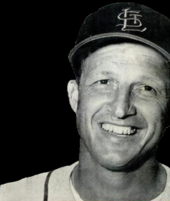
Stan Musial retired owning numerous National League and team batting records. The Gashouse Gang edition claimed the 1934 World Series[22] and the Cardinals amassed new thresholds of popularity far outside St. Louis via radio, which led to the coining of the term "Cardinal Nation".[38]
Super Puzzle Fighter II Turbo HD Remix
Super Puzzle Fighter II Turbo HD Remix theme by Itachi1986
Download: SuperPuzzleFighterIITurbo.p3t
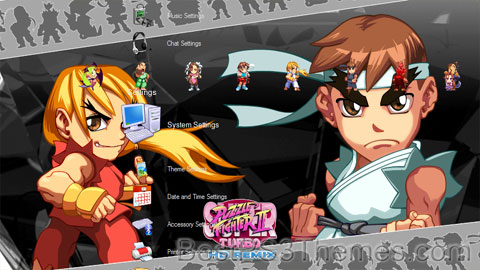
(3 backgrounds)
This page is a redirect. The following categories are used to track and monitor this redirect:- With history: This is a redirect from a page containing substantive page history. This page is kept as a redirect to preserve its former content and attributions. Please do not remove the tag that generates this text (unless the need to recreate content on this page has been demonstrated), nor delete this page.
- This template should not be used for redirects having some edit history but no meaningful content in their previous versions, nor for redirects created as a result of a page merge (use {{R from merge}} instead), nor for redirects from a title that forms a historic part of Wikipedia (use {{R with old history}} instead).
When appropriate, protection levels are automatically sensed, described and categorized.- To a section: This is a redirect from a topic that does not have its own page to a section of a page on the subject. For redirects to embedded anchors on a page, use {{R to anchor}} instead.
- From other capitalisation: This is a redirect from a title with another method of capitalisation. It leads to the title in accordance with the Wikipedia naming conventions for capitalisation, or it leads to a title that is associated in some way with the conventional capitalisation of this redirect title. This may help writing, searching and international language issues.






